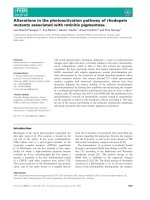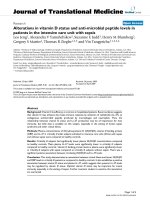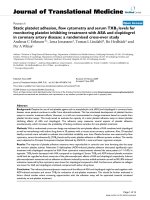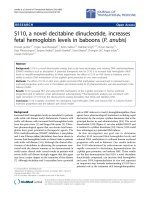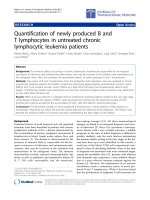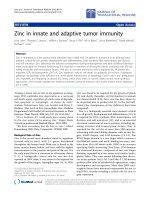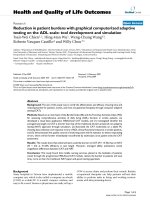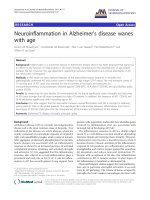báo cáo hóa học:" Alterations in vitamin D status and anti-microbial peptide levels in patients in the intensive care unit with sepsis" pot
Bạn đang xem bản rút gọn của tài liệu. Xem và tải ngay bản đầy đủ của tài liệu tại đây (638.08 KB, 9 trang )
BioMed Central
Page 1 of 9
(page number not for citation purposes)
Journal of Translational Medicine
Open Access
Research
Alterations in vitamin D status and anti-microbial peptide levels in
patients in the intensive care unit with sepsis
Leo Jeng
1
, Alexandra V Yamshchikov
2
, Suzanne E Judd
3
, Henry M Blumberg
2
,
Gregory S Martin
4
, Thomas R Ziegler
1,3,5
and Vin Tangpricha*
1,3,5,6
Address:
1
Division of Endocrinology, Diabetes & Lipids, Department of Medicine, Emory University School of Medicine, Atlanta, GA, USA,
2
Division of Infectious Diseases, Department of Medicine, Emory University School of Medicine, Atlanta, GA, USA,
3
Nutrition and Health Sciences
Program, Graduate Division of Biological and Biomedical Sciences, Emory University, Atlanta, GA, USA,
4
Division of Pulmonary and Critical Care
Medicine, Department of Medicine, Emory University School of Medicine, Atlanta, GA, USA,
5
Center for Clinical and Molecular Nutrition,
Department of Medicine, Emory University School of Medicine, Atlanta, GA, USA and
6
Atlanta VA Medical Center, Decatur, Georgia
Email: Leo Jeng - ; Alexandra V Yamshchikov - ; Suzanne E Judd - ;
Henry M Blumberg - ; Gregory S Martin - ; Thomas R Ziegler - ;
Vin Tangpricha* -
* Corresponding author
Abstract
Background: Vitamin D insufficiency is common in hospitalized patients. Recent evidence suggests
that vitamin D may enhance the innate immune response by induction of cathelicidin (LL-37), an
endogenous antimicrobial peptide produced by macrophages and neutrophils. Thus, the
relationship between vitamin D status and LL-37 production may be of importance for host
immunity, but little data is available on this subject, especially in the setting of human sepsis
syndrome and other critical illness.
Methods: Plasma concentrations of 25-hydroxyvitamin D (25(OH)D), vitamin D binding protein
(DBP) and LL-37 in critically ill adult subjects admitted to intensive care units (ICUs) with sepsis
and without sepsis were compared to healthy controls.
Results: Critically ill subjects had significantly lower plasma 25(OH)D concentrations compared
to healthy controls. Mean plasma LL-37 levels were significantly lower in critically ill subjects
compared to healthy controls. Vitamin D binding protein levels in plasma were significantly lower
in critically ill subjects with sepsis compared to critically ill subjects without sepsis. There was a
significant positive association between circulating 25(OH)D and LL-37 levels.
Conclusion: This study demonstrates an association between critical illness and lower 25(OH)D
and DBP levels in critically ill patients as compared to healthy controls. It also establishes a positive
association between vitamin D status and plasma LL-37, which suggests that systemic LL-37 levels
may be regulated by vitamin D status. Optimal vitamin D status may be important for innate
immunity especially in the setting of sepsis. Further invention studies to examine this association
are warranted.
Published: 23 April 2009
Journal of Translational Medicine 2009, 7:28 doi:10.1186/1479-5876-7-28
Received: 24 January 2009
Accepted: 23 April 2009
This article is available from: />© 2009 Jeng et al; licensee BioMed Central Ltd.
This is an Open Access article distributed under the terms of the Creative Commons Attribution License ( />),
which permits unrestricted use, distribution, and reproduction in any medium, provided the original work is properly cited.
Journal of Translational Medicine 2009, 7:28 />Page 2 of 9
(page number not for citation purposes)
Introduction
Vitamin D is a pro-hormone important for serum calcium
and phosphorus homeostasis for proper neuromuscular
function and optimal skeletal health. Vitamin D can be
obtained from the diet or made in the skin after exposure
to ultraviolet B radiation from the sun. Vitamin D is then
converted to its major circulating form, 25-hydroxyvita-
min D (25(OH)D), by the liver and to its hormonally
active form, 1,25-dihydroxyvitamin D (1,25(OH)
2
D), by
the kidney to increase the efficiency of intestinal absorp-
tion of calcium as its classic function.
Recent studies suggest that vitamin D may have other
actions outside of its classic functions related to bone and
calcium homeostasis [1]. Cells of the innate and adaptive
immune system including macrophages, lymphocytes
and dendritic cells express the vitamin D receptor (VDR)
and respond to stimulation by 1,25(OH)
2
D [2,3]. Cathe-
licidin (known as LL-37; which is cleaved from its precur-
sor hCAP18) is an endogenous antimicrobial peptide
(AMP) active against a broad spectrum of infectious
agents including gram negative and positive bacteria,
fungi and mycobacteria [4]. In vitro, 1,25(OH)
2
D
3
treat-
ment of cultured macrophages infected with Myobacterium
tuberculosis (M. tb) leads to enhanced expression of cathe-
licidin [3]. Cathelicidin is highly expressed at barrier sites
including respiratory and colonic epithelium, saliva, and
skin and thus provides an important first line defense
mechanism for the innate immune system to respond to
infectious insults. Stimulated macrophages cultured in
vitamin D deficient sera are unable to up-regulate LL-37
and effectively kill M. tb [3]. The addition of 25(OH)D to
the media up-regulated production of LL-37 and restored
effective killing of M. tb, suggesting that vitamin D has an
important role in the production of anti-microbial pep-
tides important for innate immunity [3].
Patients with severe infections as in sepsis have a high
prevalence of vitamin D deficiency [5,6] and high mortal-
ity rates [7]. Furthermore, epidemiologic findings have
implicated vitamin D insufficiency as a risk factor for sep-
sis [8]. The role of vitamin D treatment in sepsis syndrome
has been evaluated in animal models of sepsis where
1,25(OH)
2
D
3
administration was associated with
improved blood coagulation parameters in sepsis associ-
ated disseminated intravascular coagulation (DIC) [9,10].
Vitamin D treatment in vitro has also been demonstrated
to modulate levels of systemic inflammatory cytokines
such as TNF-α and IL-6 [11,12], as well as to inhibit LPS-
induced activation and vasodilation [13] of the vascular
endothelium. These effector functions of vitamin D may
be of importance in the pathogenesis of sepsis and sepsis-
related DIC, especially when considered together with the
potential for vitamin D to enhance anti-microbial peptide
production. Furthermore, serum levels of vitamin D bind-
ing protein (DBP), the major carrier protein of vitamin D,
are decreased in the setting of sepsis leading to lowered
levels of 25(OH)D [14].
The role of vitamin D in sepsis syndrome has not been
fully evaluated in humans. Therefore, we performed a
cross-sectional study of vitamin D status including plasma
levels of 25(OH)D and vitamin D binding protein (DBP)
and their relationship to systemic LL-37 levels in a group
of critically ill patients including those with and without
sepsis.
Methods
Study Sample and Subjects
This study was approved by the Emory University Institu-
tional Review Board. Samples were taken from three
patient populations: Group 1 consisted of 24 critically ill
subjects in the intensive care unit (ICU) patients diag-
nosed with sepsis (as defined by the American College of
Chest Physicians (ACCP) and Society of Critical Care
Medicine (SCCM) consensus panel in 2001 [15]; Group 2
consisted of 25 ICU subjects without the diagnoses of sep-
sis, and Group 3 consisted of 21 healthy non-hospitalized
controls. Samples were collected between January of 1999
and May of 2006. Group 1 samples were drawn within 2
days of severe sepsis onset and were drawn from the med-
ical intensive care unit between June 2004 and February
2006. Group 2 samples were drawn during the subject's
hospital day, which was a mean of 12.8 days.
Critically ill subjects (groups 1 and 2) were characterized
by sex, race, Acute Physiology and Chronic Health Evalu-
ation II (APACHEII) and sequential organ failure assess-
ment (SOFA) scores (for ICU patients) and whether they
were diagnosed with cardiovascular disease (ischemic
heart disease or congestive heart failure), liver disease,
chronic renal failure, diabetes, HIV, or cancer. Subjects
also had baseline laboratory tests performed by standard
hospital laboratory methods including albumin, pro-
thrombin time (PT), partial thromboplastin time (PTT),
INR (International Normalized Ratio), Alanine ami-
notranferease (ALT), aspartate aminotransferase (AST),
blood urea nitrogen (BUN), creatinine (Cr), hemoglobin,
and white blood cell count. Diagnoses and laboratory
data were obtained from discharge summaries and com-
puter databases.
Healthy control subjects (group 3) were adults without
known acute or chronic diseases, no hospitalizations for
any illness previous 12 months, not taking any medica-
tions or vitamin supplements. They were screened for
inclusion by a physician (TRZ) in General Clinical
Research Clinic (GCRC) setting to confirm normal history
and physical exam and had normal complete blood
Journal of Translational Medicine 2009, 7:28 />Page 3 of 9
(page number not for citation purposes)
count, chemistry profile and urinalysis, which were tested
within 2 weeks of screening.
Plasma collection and 25(OH)D, vitamin D binding protein
and LL-37 concentrations
Plasma was collected after informed consent was obtained
from either the donor or from their family. Plasma sam-
ples were obtained in EDTA tubes and centrifuged for 20
minutes at 1100 – 1300 rpm. The plasma was stored at -
80°C prior to analysis. Plasma levels of 25(OH)D and
vitamin D binding protein (DBP) were assessed using
ELISA (IDS, LTD, Fountain Hills, Arizona & Alpco, Salem,
New Hampshire, respectively). Plasma levels of LL-37
were determined by ELISA (Hycult biotechnology, Uden,
The Netherlands). Protocols for each assay were per the
manufacturer's product manuals. Samples for 25(OH)D
and DBP were tested in duplicates and LL-37 in single
measurements. The intra-assay CV for 25(OH)D, DBP and
LL-37 were <8%, <5% and <10%, respectively. The inter-
assay CV for 25(OH)D, DBP and LL-37 were <10%, <13%
and <10%, respectively. Vitamin D insufficiency was
defined as a 25(OH)D concentration < 30 ng/mL.
Statistical analysis
We used GraphPad Prism version 4.0 software (La Jolla,
CA) to compare means of each of the lab values across the
three groups of patients (critical ill subjects with and with-
out sepsis and healthy controls). Multiple regression was
used to calculate adjusted least squares means using
PROC GLM in SAS 9.1 (SAS Institute Cary, NC) between
the three subject populations. Fisher's exact test was used
to examine differences in race across the three patient
groups. Similarly, patients with darker skin pigmentation
are at increased risk for vitamin D deficiency due to the
absorption of solar radiation between 290 to 700 nm by
melanin [15], therefore, we controlled for racial differ-
ences in all multivariate models. We also examined age
and BMI as potential covariates but they were not signifi-
cantly associated with LL-37. One patient sample was
dropped from the analysis because the LL-37 level was
more than three standard deviations from the mean. Data
are presented as means ± SD.
Results
Patient demographics
The three groups of subjects (critically ill subjects with and
without sepsis and healthy controls) were similar in distri-
bution of gender and age. Co-morbid conditions that
existed prior to hospital admission including underlying
liver disease, diabetes, cardiovascular disease, and malig-
nancy were similar among the three groups. Four subjects
with HIV were present in the critically ill group with sepsis
and not present in the other two groups. There were sig-
nificantly more patients of black or African-American race
in critically ill group with sepsis compared to the critically
ill group without sepsis but was similar to the healthy
controls (Table 1).
Critically ill subjects with sepsis exhibited higher severity
of illness scores (APACHEII and SOFA) than critically ill
subjects without sepsis. APACHEII and SOFA scores were
not applied to healthy controls. In addition, critically ill
subjects with sepsis had significantly more derangements
in metabolic and hematologic parameters than ICU con-
trol subjects and healthy subjects (Table 1). For example,
critically ill subjects with sepsis had significantly higher
INR, BUN and creatinine measurements, signifying
increased incidence of multiple organ dysfunction and
DIC in the setting of sepsis syndrome. Each of the two crit-
ically ill groups also demonstrated a significantly higher
prevalence of anemia and leukocytosis than healthy con-
trols, as expected in the setting of illness requiring inten-
sive care. Both critically ill groups also had significantly
lower serum albumin, indicating that the two groups had
higher disease severity and possibly more nutritionally
impaired than healthy controls (Table 1).
Plasma 25-hydroxyvitamin D, Vitamin D Binding Protein,
and LL-37 Concentrations in Critically Ill Subjects With
and Without Sepsis and Healthy Subjects
Vitamin D status differed in the critically ill subjects with
sepsis, critically ill subjects without sepsis and healthy
controls (p < 0.0001, ANOVA). Race adjusted 25(OH)D
concentrations demonstrated no significant differences in
25(OH)D between the two critically ill groups. However,
the mean race adjusted 25(OH)D level in the two criti-
cally ill groups (16.0 ± 8.5 and 16.2 ± 7.2 ng/mL, sepsis
and non-sepsis respectively) was significantly lower than
healthy controls (26.0 ± 7.6 ng/mL) (Figure 1). The prev-
alence of vitamin D insufficiency (defined as 25(OH)D <
30 ng/ml) in critically ill subjects with sepsis was 100%
(24/24) and 92% (23/25) in critically ill subjects without
sepsis. In contrast, the prevalence of vitamin D insuffi-
ciency in the healthy controls was 66.5% (14/20) (p =
0.003); there was no significant difference in the preva-
lence of vitamin D insufficiency between the two critically
ill groups (p = 0.15).
There was a statistically significant difference in plasma
vitamin D binding protein between the three groups of
subjects (ANOVA, p = 0.014) (Figure 2). Subjects with
sepsis had significantly lower DBP concentrations com-
pared to subjects without sepsis (Figure 2). Race was not
associated with DBP levels. Cathelicidin (LL-37) concen-
trations differed in the three groups (p = 0.002, ANOVA).
Both groups of critically ill subjects had similar plasma LL-
37 concentrations (Figure 3, 13.7 ± 2.1 ng/mL vs. 10.6 ±
1.4 ng/mL; P = 0.59). However, mean plasma LL-37 levels
in healthy controls (27.2 ± 4.9 ng/mL) were significantly
higher than compared to the critically ill groups (p <
Journal of Translational Medicine 2009, 7:28 />Page 4 of 9
(page number not for citation purposes)
Table 1: Baseline Demographics of Patient Groups
ICU
Sepsis
ICU
Controls
Healthy
Controls
ANOVA
P-value
Number of Subjects 24 25 21
Age, mean (SD) 54.0 (17.1) 56.1 (15.9) 46.5 (6.1) 0.13
Male Gender, n (%) 15 (58) 13 (52) 17 (80) 0.49
Black or African
American race, n (%)
22 (92)† 14 (56) 15 (71) 0.02
White race, n (%) 2 (8) 11 (44) 5 (29) 0.02
HIV infected, n (%) 4 (17) 0 0 0.02
Diabetes, n (%) 9 (38) 6 (24) 2 (10) 0.09
Cardiovascular disease, n (%) 14 (58) 17 (68) 8 (38) 0.12
Malignancy, n (%) 2 (8) 0 1 (5) 0.35
APACHE Score,
mean (SD)
25.7 (7.4) 11.8 (5.4) N/A <0.0001
SOFA, mean (SD) 11.9 (4.0) 5.3 (3.2) N/A <0.0001
Albumin, mean (SD) mg/dL 2.0 (2.6)‡ 2.1 (0.7)# 4.0 (0.5) <0.0001
Prothrombin Time
(PT) mean (SD)*
16.7 (2.9) 15.3 (2.8) 16.8 (3.9) 0.98
Partial thromboplastin time
(PTT) mean (SD)*
48.8 (37.0) 35.1 (5.3) 34.8 (1.7) 0.05
INR, mean (SD) 1.6 (0.4)†‡ 1.2 (0.3) 1.3 (0.4) 0.0009
AST, mean (SD),
units/L
87.0 (131) 49.9 (48) 33.0 (26) 0.09
ALT, mean (SD),
units/L
43.6 (44) 51.3 (75) 25.4 (17) 0.24
BUN, mean (SD),
mg/dL
52.4 (28) †‡ 27.8 (17)# 12.6 (5.1) <0.0001
Creatinine, mean (SD),
mg/dL
4.0 (3.2) †‡ 1.1 (0.7) 1.0 (1.1) <0.0001
Hemoglobin, mean
(SD) g/dL
9.8 (2.0)‡ 10.6 (1.2)# 13.8 (1.1) <0.0001
White Blood Count
(cells/μL)
17.3 (13)‡ 15.2 (7.1)# 6.5 (1.9) <0.0002
* in seconds
Tukey-Kramer Multiple Comparisons Test
† P < 0.05, ICU Sepsis vs ICU Controls
‡ P < 0.05, ICU Sepsis vs Healthy Controls
# P < 0.05, ICU Control vs Healthy Controls
Journal of Translational Medicine 2009, 7:28 />Page 5 of 9
(page number not for citation purposes)
0.001, Tukey-Kramer for both comparisons) (Figure 3).
While adiposity has been associated with 25(OH)D lev-
els, we tested the association of BMI with LL-37 and
showed no statistical significant relationship (p = 0.20).
Therefore, BMI was not used in any of our models. Plasma
LL-37 levels also were not significantly associated with age
or race.
Vitamin D status and relationship to LL-37 levels
To determine whether there was an association between
25(OH)D and LL-37, we plotted LL-37 levels against
25(OH)D in all subjects in this study. We found a positive
linear correlation between 25(OH)D and LL-37 (R =
0.2385, p = 0.049), which remained statistically signifi-
cant after controlling for race (Figure 4, R = 0.28, p = .05).
When we reran our linear regression and included the
group category as both a covariate and interaction term
with 25(OH)D, the interaction was not statistically signif-
icant (p = 0.72). However, group was a significant predic-
tor and increased the r-squared of the model from 0.05 to
0.21. The p-value for 25(OH)D remained at 0.05.
Discussion
We have demonstrated that vitamin D insufficiency is
highly prevalent in all three populations. Even in healthy
controls, over sixty percent were found to be vitamin D
insufficient. However, the prevalence of vitamin D insuf-
ficiency is even higher in subjects admitted to the inten-
sive care unit with critical illness. We also demonstrate
that vitamin D binding protein levels are significantly
lower in critically ill subjects with sepsis compared to crit-
ically ill subjects without sepsis and healthy controls.
When we examined plasma levels of the endogenous anti-
microbial peptide LL-37 in relationship to 25(OH)D, we
found that lower levels of 25(OH)D were also associated
with lower systemic levels of LL-37. This association sup-
ports recent in vivo data that vitamin D plays some roles in
regulating the production of antimicrobial peptides such
as LL-37 in cultured macrophages [3]. Since many cells of
the immune system possess the vitamin D receptor, vita-
min D status may prove to be an important factor in man-
agement of sepsis syndrome and other critical illness.
Vitamin D insufficiency is a common condition in
patients admitted to the intensive care unit [5,16-18]. We
found that > 95% of our critically ill patients had vitamin
D insufficiency. Patients with critical illness likely had
vitamin D insufficiency which preceded their hospitaliza-
tion since several studies have documented a high preva-
lence of vitamin D insufficiency in hospitalized patients
[19-21]. Vitamin D insufficiency continues to remain a
health concern in hospitalized patients since few treat-
ment guidelines exist to address vitamin D status. The
American Society for Parenteral and Enteral Nutrition rec-
ommend only 200 IU of vitamin D daily for hospitalized
patients [22]. Heaney estimates that a dose of 400 IU daily
would only raise 25(OH)D concentrations by 2.8 ng/mL,
leaving most hospitalized patients vitamin D insufficient
[23]. Van den Berghe et al evaluated increased vitamin D
repletion of critically ill subjects with 500 IU of vitamin D;
however, 25(OH)D concentrations still remained in the
insufficient range [6]. Thus, these studies suggest that
higher recommended doses of vitamin D are likely
needed to correct vitamin D insufficiency in hospitalized
patients.
We found that vitamin D binding protein (DBP, and also
known as Gc-globulin) concentrations were also signifi-
cantly lower in critically ill subjects with sepsis compared
to critically ill subjects without sepsis and healthy control
subjects. Our findings are consistent with Dahl et al who
reported that lowered DBP was associated with sepsis and
organ dysfunction [14]. Vitamin D binding protein is the
major carrier protein for circulating 25(OH)D. Adequate
levels of DBP are required to recover filtered 25-hydroxy-
vitamin D lost in the urine [24]. This process is facilitated
by megalin, a protein located on the renal epithelial cell
which binds to the DBP-25-hydroxyvitamin D complex to
facilitate the recovery of filtered vitamin D metabolites
[25]. Lower DBP results in further loss of urinary
25(OH)D further exacerbating already low levels of circu-
lating 25(OH)D concentrations.
Vitamin D binding protein not only is a carrier for the two
major circulating forms of vitamin D, 25-hydroxyvitamin
D and 1,25-dihydroxyvitamin D, but it is also a scavenger
of monomeric actin thus preventing its polymerization
into F-actin [25,26]. The actin binding characteristics of
DBP may play a protective role in sepsis to prevent polym-
erization of actin released from injured tissue which can
in turn result in microembolization of end-organs
[25,26]. Actin binding with DBP results in lowered DBP
concentrations which in turn further lowers 25(OH)D
due to renal wasting of vitamin D and its metabolites, pro-
viding another mechanism to explain why vitamin D
insufficiency is common in patients with sepsis.
The classic function of vitamin D is to maintain optimal
calcium and skeletal homeostasis. Nierman and Mechan-
ick reported the majority of their cohort of chronically ill
elderly patients transferred from the intensive care unit
had evidence of rapid bone turnover due to vitamin D
deficiency [5]. Recent evidence suggests that vitamin D
may also play an important role in enhancing innate
immunity against infection. Liu et al demonstrated that
1,25(OH)
2
D
3
treatment of macrophages infected with
Mycobacterium tuberculosis in vitro resulted in enhanced
production of an endogenous anti-microbial peptide,
cathelicidin or LL-37, and in improved killing of the
microorganisms [3]. LL-37 has a broad antimicrobial
Journal of Translational Medicine 2009, 7:28 />Page 6 of 9
(page number not for citation purposes)
spectrum and has been demonstrated to possess multiple
other immunoregulatory functions, from chemoattrac-
tion of inflammatory cells, to promotion of wound heal-
ing, and regulation of angiogenesis [27]. Administration
of LL-37 has been demonstrated to be protective in rodent
models of sepsis [28,29]. A recent randomized, placebo
controlled trial of vitamin D supplementation in patients
with pulmonary tuberculosis in Indonesia demonstrated
significantly higher sputum conversion rates at earlier
time points in the group randomized to receive vitamin D
compared to the group assigned placebo [30]. A smaller
study of post-menopausal women also suggested that
vitamin D may have activity against influenza [31]. Given
early findings in pre-clinical studies and some early clini-
cal studies, optimal levels of vitamin D may be necessary
for enhanced anti-microbial peptide production for
improved innate immunity against infection. No prospec-
tive clinical study has confirmed that intervention with
vitamin D would raise LL-37 concentrations and improve
activity against infection.
One of the potential weaknesses of the study was that the
three groups of patients were not equally matched for race
which could impact 25(OH)D levels. However, after
adjustment for the potential confounder of race, we found
that critically ill subjects still had lower vitamin D status
than healthy controls. Also, HIV patients were only found
in the ICU sepsis group (n = 4, 16.7%). The mean LL-37
of the HIV infected subjects was not statistically different
Vitamin D status in critically ill subjects with sepsis, critically ill subjects without sepsis and healthy subjectsFigure 1
Vitamin D status in critically ill subjects with sepsis,
critically ill subjects without sepsis and healthy sub-
jects. Plasma 25-hydroxyvitamin D levels in critically ill sub-
jects with sepsis (hatched bar) and in critically ill control
subjects without sepsis (dark bar) were significantly lower
than healthy controls (white bar) (ANOVA, p < 0.0001). 25-
hydroxyvitamin D concentrations were adjusted for race. ‡ p
< 0.001, critically ill sepsis subjects compared to healthy con-
trols. # p < 0.01, critically ill control subjects compared to
healthy controls.
Plasma vitamin D binding protein in critically ill subjects with sepsis, critically ill subjects without sepsis and healthy sub-jectsFigure 2
Plasma vitamin D binding protein in critically ill sub-
jects with sepsis, critically ill subjects without sepsis
and healthy subjects. Plasma vitamin D binding protein
concentrations were significantly lower in critically ill sub-
jects with sepsis (hatched bar) compared to critically ill con-
trol subjects (dark bar) (white bar) (ANOVA, p = 0.014). † p
= < 0.05, critically ill sepsis subjects compared to critically ill
control subjects.
Anti-microbial peptide cathelicidin (LL-37) in critically ill sub-jects with sepsis, critically ill subjects without sepsis and healthy subjectsFigure 3
Anti-microbial peptide cathelicidin (LL-37) in criti-
cally ill subjects with sepsis, critically ill subjects with-
out sepsis and healthy subjects. Plasma LL-37 levels were
significantly lower in the two critical ill groups (with sepsis,
hatched bar and without sepsis, dark bar) compared to the
healthy controls subjects (white bar) (ANOVA, p= 0.002).
There was no statistically significant difference between LL-
37 levels in the two critically ill groups. ‡ p < 0.001, critically
ill sepsis subjects compared to healthy controls. # p < 0.001,
critically ill control subjects compared to healthy controls.
Journal of Translational Medicine 2009, 7:28 />Page 7 of 9
(page number not for citation purposes)
from the overall mean of the sepsis group. HIV patients
had significantly lower mean 25(OH)D levels (10.3 ± 5.2
ng/mL); however, due to the small number of HIV
patients, it is difficult to ascertain if HIV infection inde-
pendently influences 25(OH)D concentrations.
Our cross-sectional study design does not allow us to
determine whether restoring vitamin D status to optimal
levels would increase LL-37 levels systemically or result in
improved immunity against infection. It is unknown at
this time whether circulating levels of LL-37 translate
directly into antimicrobial activity. It is our hypothesis
that optimal vitamin D status would translate in increased
levels of LL-37 to enhance clearance of infections, but this
has yet to be proven in clinical studies. Rigorous interven-
tion-based clinical studies are needed to further delineate
the causal relationship between vitamin D and LL-37 in
the human host and to assess the clinical implications of
this relationship in the setting of critical illness, in partic-
ular whether optimization of vitamin D levels are associ-
ated with improved clinical outcomes. Also, another
limitation of our study is that the acute-phase reaction
associated with the medical conditions leading to ICU
admission may possibly depress 25(OH)D and LL-37 lev-
els. More clinical studies are needed to examine the effect
of vitamin D status and LL-37 on downstream production
of inflammatory cytokines and coagulation factors, as
these parameters are important in the pathogenesis of sep-
sis syndrome and other severe illness. Future studies
should also focus on whether improved vitamin D status
would have a more pronounced effect on levels of LL-37
and other antimicrobial peptides potentially regulated by
vitamin D at immunologic barrier sites, such as the sur-
face of the skin [32] and the surface fluid of the respiratory
airways [33], in addition to modulating systemic levels of
antimicrobial peptides.
In conclusion, we have determined that nearly all criti-
cally ill patients we studied had sub-optimal vitamin D
status and a higher rate of vitamin D insufficiency com-
pared to healthy subjects. This finding is associated with
lower systemic levels of LL-37, a vitamin D dependent
antimicrobial peptide which appears to have multiple
effector roles within the immune system. Vitamin D bind-
ing protein (DBP) levels were also significantly decreased
in critically ill subjects with sepsis which further exacer-
bates vitamin D insufficiency. Whether this effect is due to
decreased vitamin D binding protein synthesis, increased
clearance and/or increased catabolism is unknown. Vita-
min D may have an important role in regulation of the
immune system through induction of such antimicrobial
peptides in patients with critical illness, who are known to
have a high prevalence of vitamin D insufficiency. Results
of this clinical study provide important background to
perform larger scale, intervention based trials of adjunc-
tive vitamin D therapy in a variety of clinical settings,
including further studies in the management of human
sepsis syndrome and other critical illnesses.
Abbreviations list
25(OH)D: is 25-hydroxyvitamin D; 1,25(OH)D: is 1,25-
dihydroxyvitamin D; ACCP: is American College of Chest
Physicians; ALT: is alanine aminotranferease; AMP: is
anti-microbial Peptide; APACHEII: is Acute Physiology
and Chronic Health Evaluation II; AST: is aspartate ami-
notransferase; BUN: is blood urea nitrogen; Cr: is creati-
nine; DBP: is vitamin D binding protein; DIC: is
disseminated intravascular coagulation; ELISA: is
Enzyme-Linked ImmunoSorbent Assay; HIV: is human
Immunodeficiency Virus; ICU: is intensive care unit; INR:
is International Normalized. Ratio; LL-37: is human
cathelicidin; M. Tb: is Myobacteria tuberculosis; PT: is pro-
thrombin time; PTT: is partial thromboplastin time;
SCCM: is Society of Critical Care Medicine; SOFA: is
sequential organ failure assessment; UVB: is Ultraviolet B;
VDR: is vitamin D receptor
Relationship between plasma 25-hydroxyvitamin D and cathelicidin (LL-37) in critically ill subjects with sepsis, criti-cally ill subjects without sepsis and healthy subjectsFigure 4
Relationship between plasma 25-hydroxyvitamin D
and cathelicidin (LL-37) in critically ill subjects with
sepsis, critically ill subjects without sepsis and healthy
subjects. The was a positive relationship between plasma
25-hydroxyvitamin D (25(OH)D) and systemic LL-37 levels
in all three subject groups (critically ill subjects with sepsis,
critically ill without sepsis and healthy controls). This
remained significant after adjustment for differences in race
and patient population (R
2
= 0.21, P = 0.05).
Journal of Translational Medicine 2009, 7:28 />Page 8 of 9
(page number not for citation purposes)
Competing interests
The authors declare that they have no competing interests.
Authors' contributions
LJ carried out all laboratory studies (immunoassays, sam-
ple collection and preparation), helped design the study,
drafted the manuscript, organized and carried out initial
statistical analysis. AY participated in drafting the manu-
script and collecting background information. SJ carried
out statistical analysis. HB provided general supervision
and was involved in drafting the manuscript. GM pro-
vided samples, supervised in study design, and was
involved in drafting the manuscript. TZ provided samples,
supervised in study design, and was involved in drafting
the manuscript. VT carried out the initial conception and
design of the study, supervised and assisted in laboratory
techniques, and was involved in drafting the manuscript.
Acknowledgements
This research was supported in part by grants from the University Research
Committee of Emory University, National Institutes of Health Grant #
K23AR054334 and #5T32DK007298. The authors responsibilities were as
followed. LJ, LVY and SEJ: contributed to the study design and concept, sta-
tistical analysis, and writing of the manuscript. HMB, GM and TRZ: contrib-
uted to study design and concept and writing and editing of the manuscript.
VT: contributed to the study design and concept, writing and editing of the
manuscript and provided financial support for the manuscript.
References
1. Holick MF: Vitamin D deficiency. New England Journal of Medicine
2007, 357(3):266-81.
2. Adams JS, Hewison M: Unexpected actions of vitamin D: new
perspectives on the regulation of innate and adaptive immu-
nity. Nat Clin Pract Endocrinol Metab 2008, 4(2):80-90.
3. Liu PT, Stenger S, Li H, et al.: Toll-like receptor triggering of a
vitamin D-mediated human antimicrobial response. Science
2006, 311(5768):1770-3.
4. Dürr UH, Sudheendra US, Ramamoorthy A: LL-37, the only
human member of the cathelicidin family of antimicrobial
peptides. Biochim Biophys Acta 2006, 1758(9):1408-25.
5. Nierman DM, Mechanick JI: Bone hyperresorption is prevalent
in chronically critically ill patients. Chest 1998, 114(4):1122-8.
6. Berghe G Van den, Van Roosbroeck D, Vanhove P, Wouters PJ, De
Pourcq L, Bouillon R: Bone turnover in prolonged critical ill-
ness: effect of vitamin D. J Clin Endocrinol Metab 2003,
88(10):4623-32.
7. Angus DC, Linde-Zwirble WT, Lidicker J, Clermont G, Carcillo J, Pin-
sky MR: Epidemiology of severe sepsis in the United States:
analysis of incidence, outcome, and associated costs of care.
Critical Care Medicine 2001, 29(7):1303-10.
8. Grant WB: Solar ultraviolet-B irradiance and vitamin D may
reduce the risk of septicemia. Dermato-Endocrinology 2009,
1(1):1-6.
9. Asakura H, Aoshima K, Suga Y, et al.: Beneficial effect of the
active form of vitamin D3 against LPS-induced DIC but not
against tissue-factor-induced DIC in rat models. Thrombosis &
Haemostasis 2001, 85(2):287-90.
10. Moller S, Laigaard F, Olgaard K, Hemmingsen C: Effect of 1,25-dihy-
droxy-vitamin D3 in experimental sepsis. International Journal of
Medical Sciences 2007, 4(4):190-5.
11. Equils O, Naiki Y, Shapiro AM, et al.: 1,25-Dihydroxyvitamin D
inhibits lipopolysaccharide-induced immune activation in
human endothelial cells. Clin Exp Immunol 2006,
143(1):58-64.
12. Sadeghi K, Wessner B, Laggner U, et al.: Vitamin D3 down-regu-
lates monocyte TLR expression and triggers hyporespon-
siveness to pathogen-associated molecular patterns.
European Journal of Immunology 2006, 36(2):361-70.
13. Bukoski RD, Xue H: On the vascular inotropic action of 1,25-
(OH)2 vitamin D3. American Journal of Hypertension 1993, 6(5 Pt
1):388-96.
14. Dahl B, Schiødt FV, Ott P, Wians F, Lee WM, Balko J, O'Keefe GE:
Plasma concentration of Gc-globulin is associated with
organ dysfunction and sepsis after injury. Crit Care Med 2003,
31(1):152-6.
15. Levy MM, Fink MP, Marshall JC, et al.: 2001 SCCM/ESICM/ACCP/
ATS/SIS International Sepsis Definitions Conference. Critical
Care Medicine 2003, 31(4):1250-6.
16. Berghe G van den, Weekers F, Baxter RC, Wouters P, Iranmanesh A,
Bouillon R, Veldhuis JD: Five-day pulsatile gonadotropin-releas-
ing hormone administration unveils combined hypotha-
lamic-pituitary-gonadal defects underlying profound
hypoandrogenism in men with prolonged critical illness. J Clin
Endocrinol Metab 2001, 86(7):3217-26.
17. Berghe G Van den, Baxter RC, Weekers F, Wouters P, Bowers CY,
Iranmanesh A, Veldhuis JD, Bouillon R: The combined administra-
tion of GH-releasing peptide-2 (GHRP-2), TRH and GnRH to
men with prolonged critical illness evokes superior endo-
crine and metabolic effects compared to treatment with
GHRP-2 alone. Clin Endocrinol (Oxf) 2002, 56(5):655-69.
18. Berghe G Van den, Wouters P, Weekers F, Mohan S, Baxter RC,
Veldhuis JD, Bowers CY, Bouillon R: Reactivation of pituitary
hormone release and metabolic improvement by infusion of
growth hormone-releasing peptide and thyrotropin-releas-
ing hormone in patients with protracted critical illness. J Clin
Endocrinol Metab 1999, 84(4):1311-23.
19. Thomas MK, Lloyd-Jones DM, Thadhani RI, Shaw AC, Deraska DJ,
Kitch BT, Vamvakas EC, Dick IM, Prince RL, Finkelstein JS: Hypovi-
taminosis D in medical inpatients. N Engl J Med 1998,
338(12):777-83.
20. Kiebzak GM, Moore NL, Margolis S, Hollis B, Kevorkian CG: Vita-
min D status of patients admitted to a hospital rehabilitation
unit: relationship to function and progress.
Am J Phys Med Reha-
bil 1998, 86(6):777-83.
21. Giusti A, Barone A, Razzano M, Pizzonia M, Oliveri M, Palummeri E,
Pioli G: High prevalence of secondary hyperparathyroidism
due to hypovitaminosis D in hospitalized elderly with and
without hip fracture. J Endocrinol Invest 2006, 29(9):809-13.
22. ASPEN Board of Directors and the Clinical Guidelines Task Force:
Guidelines for the use of parenteral and enteral nutrition in
adult and pediatric patients. JPEN J Parenter Enteral Nutr 2002,
26(1 Suppl):1SA-138SA.
23. Heaney RP, Davies KM, Chen TC, Holick MF, Barger-Lux MJ:
Human serum 25-hydroxycholecalciferol response to
extended oral dosing with cholecalciferol. Am J Clin Nutr 2003,
77(1):204-10.
24. Nykjaer A, Dragun D, Walther D, Vorum H, Jacobsen C, Herz J,
Melsen F, Christensen EI, Willnow TE: An endocytic pathway
essential for renal uptake and activation of the steroid 25-
(OH) vitamin D3. Cell 1999, 96(4):507-15.
25. White P, Cooke N: The multifunctional properties and charac-
teristics of vitamin D-binding protein. Trends Endocrinol Metab
2000, 11(8):320-7.
26. Speeckaert M, Huang G, Delanghe JR, Taes YE: Biological and clin-
ical aspects of the vitamin D binding protein (Gc-globulin)
and its polymorphism. Clin Chim Acta 2006, 372(1–2):33-42.
27. Ramanathan B, Davis EG, Ross CR, Blecha F: Cathelicidins: micro-
bicidal activity, mechanisms of action, and roles in innate
immunity. Microbes Infect 2002, 4(3):361-372.
28. Cirioni O, Giacometti A, Ghiselli R, et al.: LL-37 protects rats
against lethal sepsis caused by gram-negative bacteria. Anti-
microb Agents Chemother 2006, 50(5):1672-1679.
29. Kirikae T, Hirata M, Yamasu H, et al.: Protective effects of a
human 18-kilodalton cationic antimicrobial protein
(CAP18)-derived peptide against murine endotoxemia.
Infect Immun 1998, 66(5):1861-1868.
30. Nursyam EW, Amin Z, Rumende CM: The effect of vitamin D as
supplementary treatment in patients with moderately
advanced pulmonary tuberculous lesion. Acta Medica Indonesi-
ana 2006, 38(1):3.
31. Aloia JF, Li-Ng M: Epidemic influenza and vitamin D. Epidemiol
Infect 2007, 135(7):1095-6.
32. Stryjewski ME, Hall RP, Chu VH, et al.: Expression of antimicrobial
peptides in the normal and involved skin of patients with
Publish with BioMed Central and every
scientist can read your work free of charge
"BioMed Central will be the most significant development for
disseminating the results of biomedical researc h in our lifetime."
Sir Paul Nurse, Cancer Research UK
Your research papers will be:
available free of charge to the entire biomedical community
peer reviewed and published immediately upon acceptance
cited in PubMed and archived on PubMed Central
yours — you keep the copyright
Submit your manuscript here:
/>BioMedcentral
Journal of Translational Medicine 2009, 7:28 />Page 9 of 9
(page number not for citation purposes)
infective cellulitis. Journal of Infectious Diseases 2007,
196(9):1425-30.
33. Beisswenger C, Bals R: Antimicrobial peptides in lung inflam-
mation. Chem Immunol Allergy 2005, 86:55-71.
